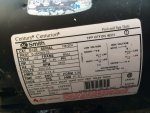As luck would have it, pool opening revealed a pump that would not prime, because of a badly cracked pump housing. The combination of a 20+ year old pump and an especially cold winter apparently does not mix well. The single speed AO Smith motor is still functional, but it is also more than 10 years old, so replacing it with an energy efficient model at the same time as the pump is an obvious option.
My local pool store quoted me an unbelievable $670 to replace the wet end, (installed) and just over $1,200 (installed) for a new Pentair Superflow VSP. Obviously I could buy a naked pump direct for much less than that - perhaps about $150 from what I can tell from a brief search. As for the full pump option, I'm thinking a two speed pump might be a better value for my situation than a variable speed pump. Looks like online pricing for a 1.5 HP two speed Pentair Superflow is running about $440. At this price point, my quick calculations on electric savings of about 50% equates to a payback period of about 2 years. Savings after the first summer would likely offset the additional upfront cost of the full pump vs. the wet end only.
So I am leaning towards just getting the whole new Pentair 1.5 HP two speed Superflow, but buying it online and installing it myself. With the projected energy savings, it will be about a wash cost-wise compared to the pump only after this summer, and break even after the second summer. I'm fairly confident I could handle the install myself, with perhaps a little bit of electrical help if need be. The plumbing looks pretty straight forward.
So is the Pentair Superflow a good product, or should I be considering something else? And does the two speed rather than a VSP make sense, assuming a moderately low electrical cost of about 12 cents per kWh and a short pool season? Recommended online vendors? Finally is this a reasonable DIY project if there is minimal plumbing or electrical changes needed?
Thanks in advance for any feedback or suggestions. Much appreciated!
My local pool store quoted me an unbelievable $670 to replace the wet end, (installed) and just over $1,200 (installed) for a new Pentair Superflow VSP. Obviously I could buy a naked pump direct for much less than that - perhaps about $150 from what I can tell from a brief search. As for the full pump option, I'm thinking a two speed pump might be a better value for my situation than a variable speed pump. Looks like online pricing for a 1.5 HP two speed Pentair Superflow is running about $440. At this price point, my quick calculations on electric savings of about 50% equates to a payback period of about 2 years. Savings after the first summer would likely offset the additional upfront cost of the full pump vs. the wet end only.
So I am leaning towards just getting the whole new Pentair 1.5 HP two speed Superflow, but buying it online and installing it myself. With the projected energy savings, it will be about a wash cost-wise compared to the pump only after this summer, and break even after the second summer. I'm fairly confident I could handle the install myself, with perhaps a little bit of electrical help if need be. The plumbing looks pretty straight forward.
So is the Pentair Superflow a good product, or should I be considering something else? And does the two speed rather than a VSP make sense, assuming a moderately low electrical cost of about 12 cents per kWh and a short pool season? Recommended online vendors? Finally is this a reasonable DIY project if there is minimal plumbing or electrical changes needed?
Thanks in advance for any feedback or suggestions. Much appreciated!




